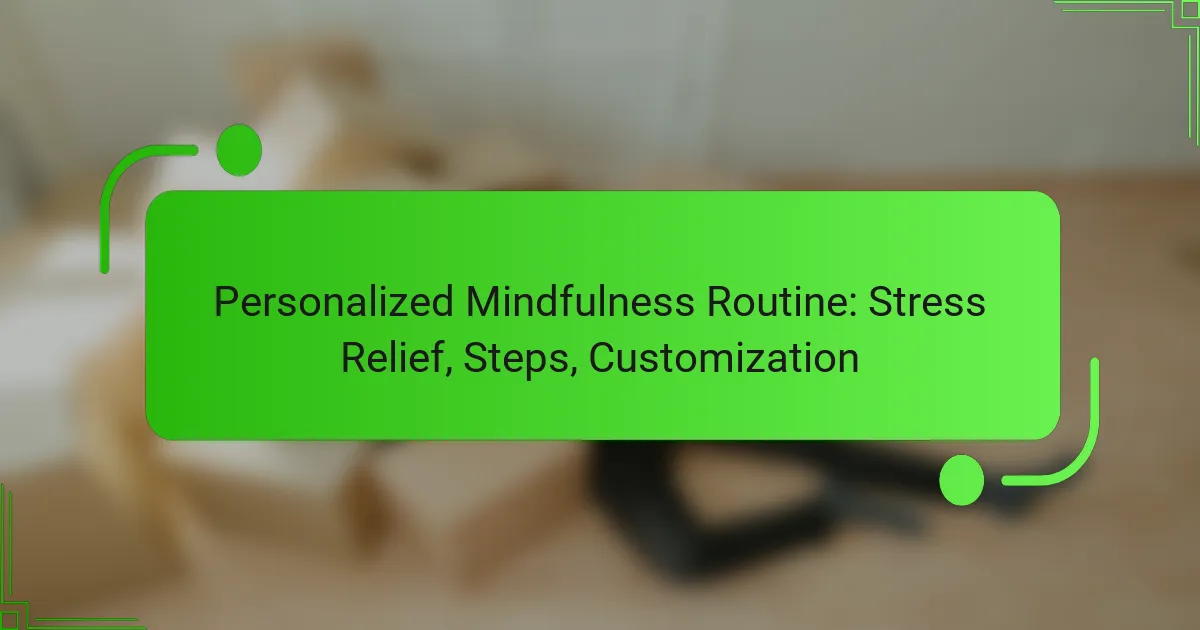Mindfulness is a powerful tool for college students seeking to manage stress, as it fosters awareness and presence in the moment. By incorporating simple mindfulness techniques into their daily routines, students can effectively reduce anxiety, enhance emotional regulation, and improve their overall well-being amidst academic pressures.
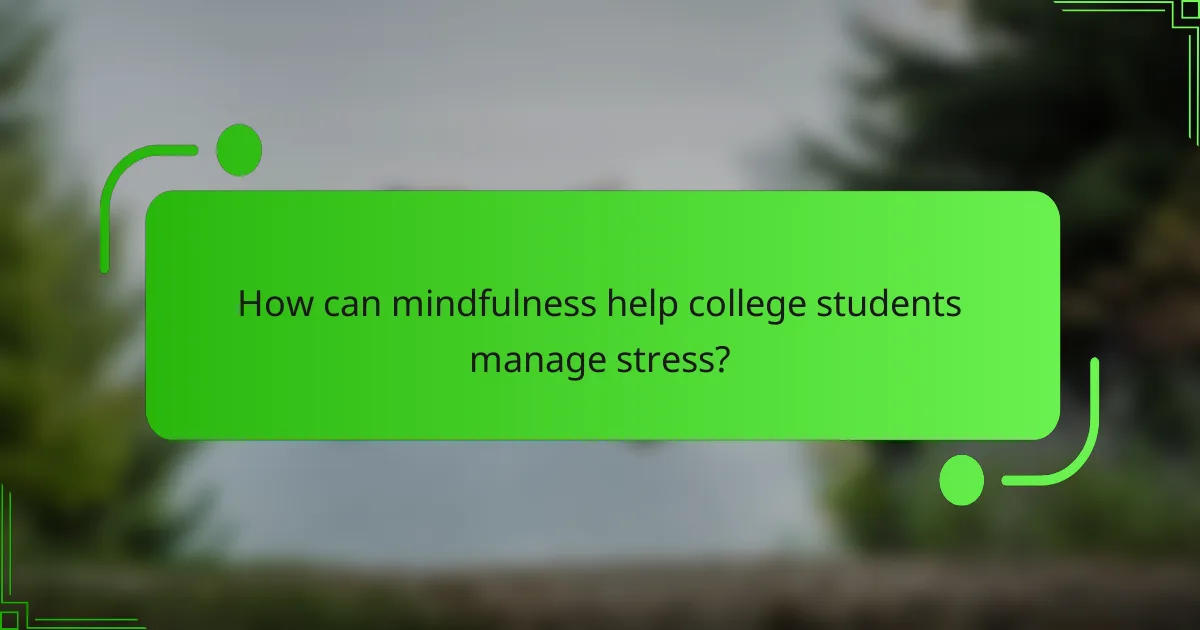
How can mindfulness help college students manage stress?
Mindfulness can significantly aid college students in managing stress by promoting awareness and presence in the moment. This practice helps reduce negative thoughts and enhances overall well-being, making it easier to navigate academic pressures.
Reduces anxiety and depression
Mindfulness techniques, such as meditation and deep breathing, can lower levels of anxiety and depression among college students. By focusing on the present, students can break the cycle of worrying about future exams or past performances, leading to a calmer mindset.
Regular mindfulness practice has been shown to decrease symptoms of anxiety by up to 30% in some studies. Engaging in just a few minutes of mindfulness each day can help students feel more grounded and less overwhelmed.
Improves focus and concentration
Practicing mindfulness enhances focus and concentration, which are crucial for academic success. Techniques like mindful breathing or body scans can train the mind to stay attentive, reducing distractions from social media or environmental noise.
Students can incorporate short mindfulness exercises into their study routines, such as taking a five-minute break to practice focused breathing. This can lead to improved retention of information and better performance on assignments and exams.
Enhances emotional regulation
Mindfulness helps college students develop better emotional regulation skills, allowing them to respond to stressors more effectively. By recognizing their emotional states without judgment, students can manage their reactions and reduce impulsive behaviors.
For instance, when faced with a stressful situation, students can pause and practice mindfulness to assess their feelings before reacting. This approach can lead to healthier coping strategies and improved interpersonal relationships within the college environment.
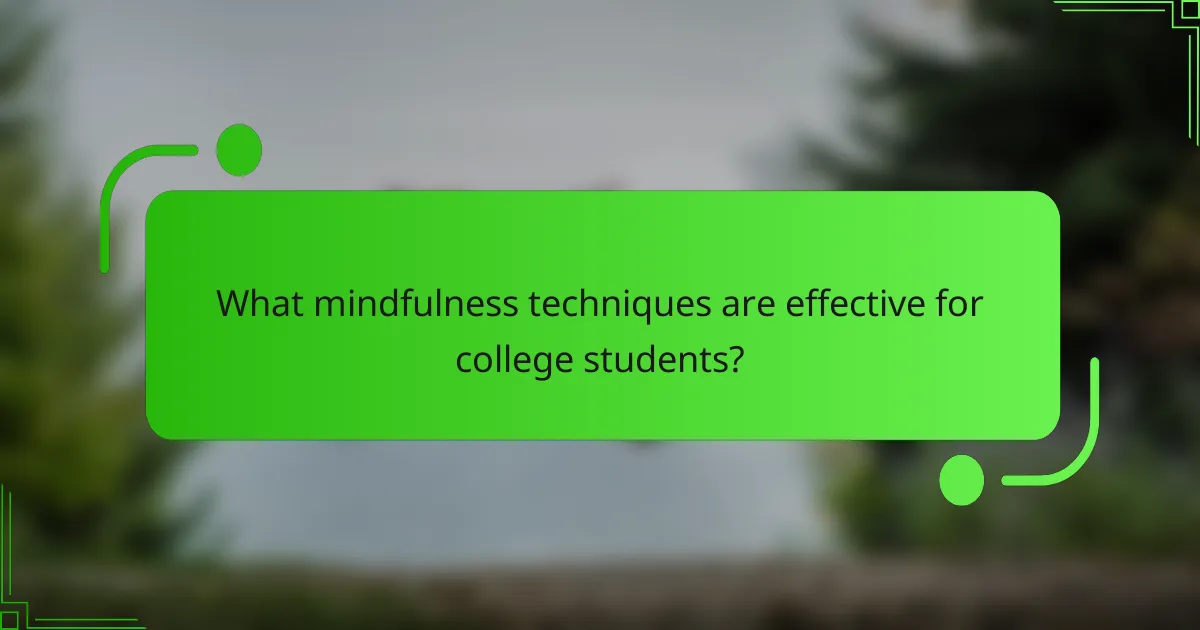
What mindfulness techniques are effective for college students?
Effective mindfulness techniques for college students include practices that promote relaxation and focus, helping to manage stress. These techniques can be easily integrated into daily routines, making them accessible for busy students.
Mindful breathing exercises
Mindful breathing exercises involve focusing on your breath to cultivate awareness and calmness. Students can practice this by taking deep, slow breaths, inhaling through the nose for a count of four, holding for four, and exhaling through the mouth for another count of four.
To enhance effectiveness, find a quiet space and set aside a few minutes daily. This can help reduce anxiety and improve concentration, especially before exams or presentations.
Body scan meditation
Body scan meditation encourages students to mentally scan their bodies for tension and stress. Lying down comfortably, students can focus on each part of their body, starting from the toes and moving up to the head, noticing sensations without judgment.
This technique can take about 10-20 minutes and is best practiced in a quiet environment. Regular practice can lead to greater body awareness and relaxation, helping students manage physical symptoms of stress.
Guided imagery
Guided imagery involves visualizing peaceful scenes or experiences to promote relaxation. Students can use audio recordings or apps that lead them through calming scenarios, such as a beach or forest.
This technique can be particularly effective for reducing anxiety before stressful events. Aim for sessions of 5-15 minutes, allowing the mind to escape and recharge.
Mindful walking
Mindful walking combines physical activity with mindfulness by encouraging students to focus on the experience of walking. This involves paying attention to each step, the sensations in the feet, and the rhythm of breathing.
Students can practice this technique on campus or in a nearby park, dedicating 10-30 minutes to the activity. It not only helps clear the mind but also provides a break from sedentary study habits, promoting both mental and physical well-being.
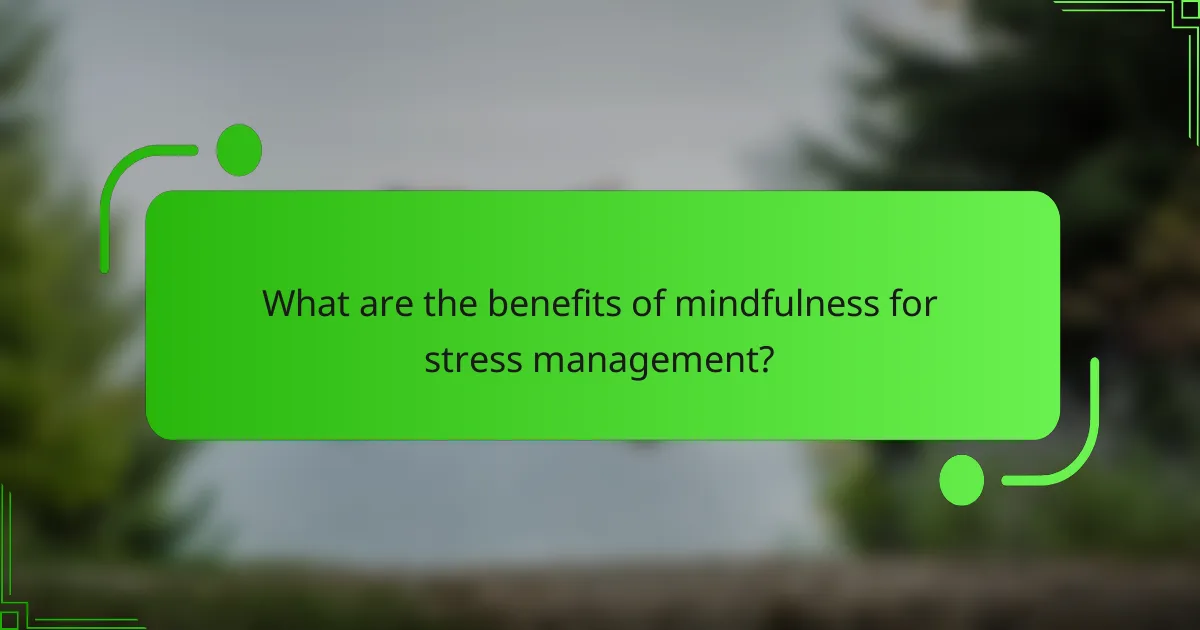
What are the benefits of mindfulness for stress management?
Mindfulness offers several benefits for stress management, particularly for college students. By cultivating awareness and presence, students can reduce anxiety, enhance emotional regulation, and improve overall well-being.
Increased resilience
Practicing mindfulness can significantly boost resilience, allowing students to better cope with stressors. By focusing on the present moment, individuals can develop a more balanced perspective, which helps them navigate challenges with greater ease.
Techniques such as mindful breathing and meditation can strengthen this resilience. Regular practice encourages a mindset that views setbacks as opportunities for growth rather than insurmountable obstacles.
Better academic performance
Mindfulness can lead to improved academic performance by enhancing concentration and reducing distractions. Students who engage in mindfulness practices often report better focus during lectures and while studying, which can translate to higher grades.
Incorporating short mindfulness exercises before exams or study sessions can help clear mental clutter. Techniques like visualization or mindful walking can prepare the mind for optimal learning and retention.
Improved relationships
Mindfulness fosters better relationships by promoting empathy and effective communication. When students practice being present, they are more likely to listen actively and respond thoughtfully to their peers.
Engaging in mindfulness together, such as through group meditation sessions, can strengthen bonds among classmates. This shared experience can create a supportive community, enhancing social connections and reducing feelings of isolation.
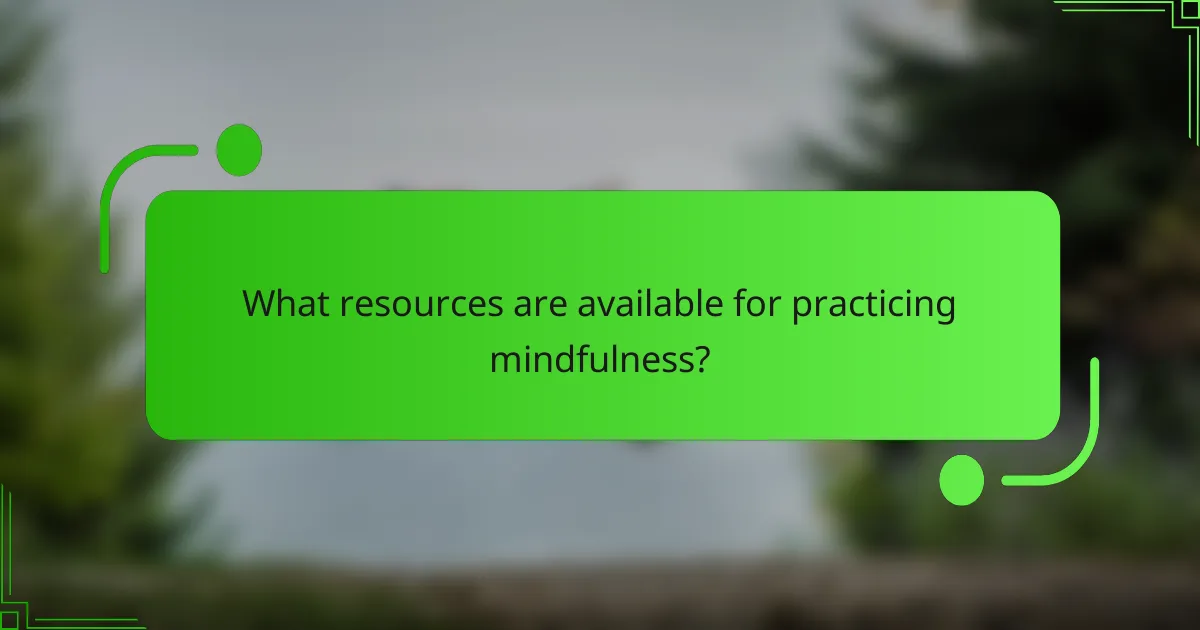
What resources are available for practicing mindfulness?
College students have access to various resources for practicing mindfulness, including mobile apps, campus wellness programs, and online courses. These tools can help manage stress effectively and improve overall well-being.
Apps like Headspace and Calm
Mindfulness apps such as Headspace and Calm offer guided meditations, sleep aids, and breathing exercises tailored for busy lifestyles. These platforms typically provide free trials, allowing students to explore their features before committing to a subscription.
Both apps include a variety of courses focused on stress management, anxiety reduction, and sleep improvement, making them suitable for different needs. Users can set reminders to practice mindfulness regularly, helping to establish a consistent routine.
Campus wellness programs
Many colleges and universities offer wellness programs that include mindfulness workshops, meditation sessions, and stress relief activities. These programs are often free or low-cost, making them accessible to all students.
Participating in campus wellness initiatives can foster a sense of community and provide support from peers and trained facilitators. Look for events advertised through campus newsletters or wellness centers to find opportunities to engage in mindfulness practices.
Online courses and workshops
Online platforms like Coursera and Udemy provide courses on mindfulness and stress management, often designed by experts in psychology and wellness. These courses can range from a few hours to several weeks, allowing students to learn at their own pace.
Many universities also offer virtual workshops that focus on mindfulness techniques, providing practical skills that students can apply in their daily lives. Consider enrolling in these courses to deepen your understanding and practice of mindfulness.
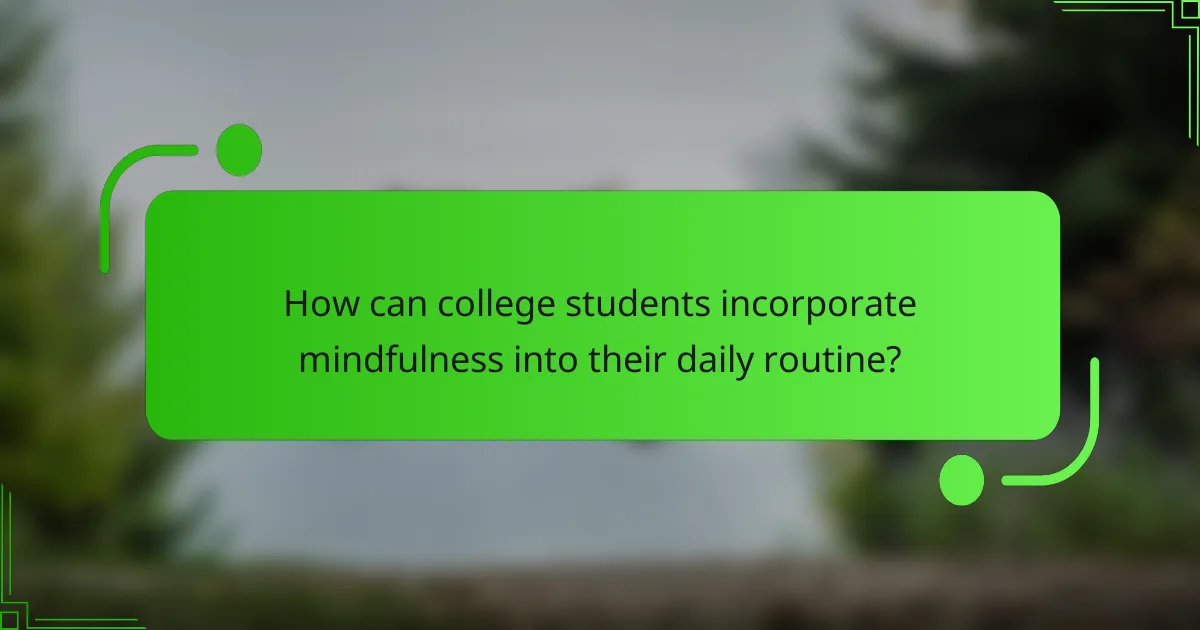
How can college students incorporate mindfulness into their daily routine?
College students can incorporate mindfulness into their daily routine by dedicating specific times for practice, creating environments that foster focus, and engaging with peers in mindfulness activities. These strategies can help manage stress and enhance overall well-being.
Setting aside time for practice
To effectively incorporate mindfulness, students should set aside dedicated time each day, even if it’s just 5-10 minutes. This could be during a morning routine, between classes, or before bedtime. Consistency is key, so choosing a specific time can help make mindfulness a habit.
Using apps or timers can assist in maintaining this practice. Students might start with guided meditations or simple breathing exercises to ease into mindfulness techniques.
Creating a supportive environment
A supportive environment is crucial for practicing mindfulness. Students can create a calming space in their dorms or apartments by minimizing distractions, such as noise and clutter. Soft lighting, comfortable seating, and calming scents can enhance the atmosphere.
Incorporating elements like plants or artwork that promote tranquility can also be beneficial. Engaging in mindfulness during quiet times, such as early mornings or late evenings, can further enhance focus.
Joining mindfulness groups
Joining mindfulness groups on campus can provide motivation and community support. Many colleges offer workshops or clubs focused on mindfulness practices, where students can learn together and share experiences. This social aspect can make the practice more enjoyable and less isolating.
Participating in group sessions, whether in-person or online, can help students stay accountable and explore different mindfulness techniques, such as yoga or meditation. These groups often provide resources and guidance that can deepen understanding and practice.

What challenges do college students face in practicing mindfulness?
College students often struggle with practicing mindfulness due to high levels of stress, time constraints, and a lack of understanding of mindfulness techniques. These challenges can hinder their ability to effectively incorporate mindfulness into their daily routines.
Time constraints
Many college students juggle classes, assignments, and part-time jobs, leaving little time for mindfulness practices. This busy schedule can make it difficult to set aside even a few minutes for meditation or reflection. Prioritizing short, manageable mindfulness exercises, such as deep breathing or quick meditations, can help fit these practices into a packed day.
High levels of stress
Academic pressures, social expectations, and financial concerns contribute to elevated stress levels among college students. This stress can create a mental block that makes it hard to focus on mindfulness. Engaging in mindfulness techniques, like progressive muscle relaxation or guided imagery, can help alleviate stress and promote a calmer mindset.
Lack of understanding
Some students may not fully grasp what mindfulness entails or how to practice it effectively. Without proper guidance, they may feel overwhelmed or unsure of where to start. Educational resources, workshops, or apps that provide structured mindfulness exercises can be beneficial in helping students learn and implement these techniques.


